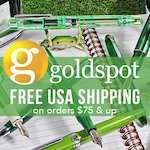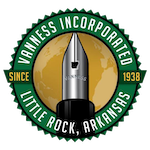(Kimberly (she/her) took the express train down the fountain pen/stationery rabbit hole and doesn't want to be rescued. She can be found on Instagram @allthehobbies because there really are many, many hobbies!.)
We all have our reasons for picking the pens we buy. Often, there is something about its look, design, shape, or color. Maybe it has a really cool nib - Monoc, stacked nibs, and flex nibs are some that come to mind. Maybe there is some personal history like a Pilot Myu that was manufactured and stamped with your birth month and year. Other times, something is so ridiculous, you can’t help but get it. That’s what happened to me at last year’s SF Pen Show.
I was at Kirk Speer’s table getting a nib grind when I saw one of the most adorably cute pens I had ever seen and I had to have it.
Wancher PuChiCo, Black Chocolate Orange, though it’s hard to tell how ridiculous it is on its own.
The PuChiCo is part of Wancher’s sub-brand 1xOnexWan, which focuses on more affordable offerings. The PuChiCo is one of three models in that lineup (the other being PoChaCo and Mofu) and costs around $25-30.
The PuChiCo is only available as an eyedropper, and it can hold ~0.5 ml of ink, which is a wee bit more than a Kaweco mini converter (a standard international cartridge can hold about 0.8 ml). I inked mine up with Diamine Orange and quickly realized that I had to leave room for the nib unit, so don’t fill it all the way!
Looking down into the barrel of the PuChiCo, you can see that there is a black o-ring - this is where the nib unit sits against once it’s screwed back in, aka this is your fill line.
I put some dark ink in it so you could see roughly how much ink it holds. The dark part near my fingers is from the black nib unit, and the bottom ⅓-½ is the ink.
You can get the PuChiCo in Extra Fine or Fine - I chose Fine. It wrote right away with no issues. I used it 26 times since I first inked it on Sept. 1 and finally wrote it dry a couple weeks ago, each time with zero issues despite how long it was since I last used it. There is also an o-ring on the nib unit to prevent leaks and having been on a dozen airplanes since I got it, there have been no burps either. I was pleasantly surprised at how nice and smooth the Fine nib felt. The nib and feed are similar in size and shape to a Kaweco Sport, but they aren’t exactly the same.
PuChiCo, Fine, with Diamine Orange.
Writing samples of the PuChiCo Fine (top), Kaweco Sport Fine (middle) and Pilot VP Fine (bottom). It’s pretty close, but the Pilot Fine is finer than the other two.
Similar size/shape nib as the Kaweco Sport (ignore the not-yet-cleaned PuChiCo.)
PuChiCo’s feed (left) has more fins and a slightly different shape.
I usually don’t post my pocket pens, not even my Schon Pocket 6 or Kaweco Sport, but I have to post the PuChiCo. It is less than 2.5” long (60mm) un posted and only 3.5” (90mm) long when posted. Even though I love how cute this PuChiCo is, as well as how nicely it writes, I wish that it posted more securely. You really have to push the cap onto the barrel, otherwise the cap pops off easily. Despite my firm posting, I haven’t seen any marks or scratches on the barrel, so that’s a plus.
PuChiCo (left) next to a Kaweco Sport.
Uncapped - I did mention how small this thing is, right?
Posted PuChiCo next to an unposted Sport. It’s still not as long as the Sport, but it’s getting there and is usable for me. Probably still unusable for folks with larger hands or who like gripping their pens further back.
This is ridiculously small unposted. It’s like I have giant hands, lol.
So much better when posted.
Comparison with other pocket pens: Left to Right: PuChiCo, Schon Dsgn Pocket 6, Ensso XS, Kaweco Liliput, Kaweco Sport, Sailor Pro Gear Mini, TWSBI Mini.
Even posted, the PuChiCo is nowhere close to the other posted pocket pens in length.
This article wouldn’t be complete if I didn’t show the PuChiCo with my other stationery for ants, the Kokuyo Campus notebook keychain (approximately A9 in size,) and a normal-sized Aurora Optima and A5 sized Kokuyo Campus notebook, both of which look enormous by comparison, lol.
I love showing it off at meetups and shows because it always elicits plenty of “Omg, what is that little thing? Does it write?” reactions. I’m hoping to get its sibling, PoChaCo, which is the larger version, and also comes in eyedropper or cartridge. The Wancher PuChiCo is available from Kirk Speer of Pen Realm in other colors, including Hawaiian Blue, Peony Pink, and others. Now to re-ink it in time for the St. Louis Pen Show next weekend!
(Disclaimer: I paid full price for the PuChiCo from Kirk Speer at the 2024 SF Pen Show. All other pens/products shown are mine.)
Enjoy reading The Pen Addict? Then consider becoming a member to receive additional weekly content, giveaways, and discounts in The Pen Addict shop. Plus, you support me and the site directly, for which I am very grateful.
Membership starts at just $5/month, with a discounted annual option available. To find out more about membership click here and join us!

































